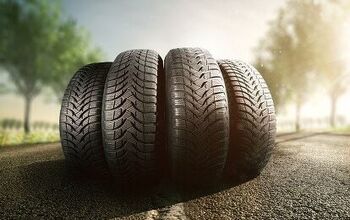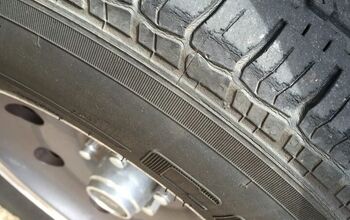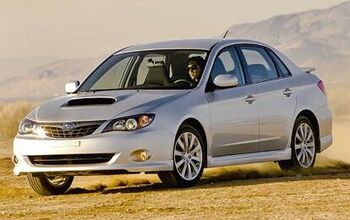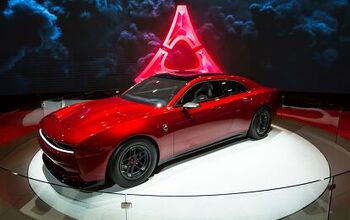Piston Slap: "Spare" Me From Dry Rot!

TTAC Commentator sastexan writes:
With the extreme cold throughout the US and seeing a few shredded tires on the highway this week (in fact, I had a flat myself – not sure what caused it but possibly doing donuts in the FR-S on a parking lot last week with lots of broken up ice on the edges), I got to thinking about spare tires.
Many of the Best and Brightest have “keeper” cars – myself included with our old Camry. Tires have limited lifespans due to dry rot, and I’m guessing spare tires are included in that category. The spare in the Camry is the original 14 year old tire (full size spare at least). How often do people change their spares, if ever? Has anyone with an aged spare had it blow out due to dry rot? Can you just order a new space saver spare off of tire rack?
Take care,
Steven
Sajeev answers:
Very interesting question, one that raises even more questions! Keep these in mind before we proceed:
- Tires dry rot slower when living in an enclosed space with no exposure to sunlight (UV rays).
- You may not see visible cracks like other rotted tires, but rest assured at some point the rubber has petrified like a rock.
- The odds of getting stranded by a rotted temporary spare is less likely than an ordinary tire, as nobody wants to roll around on that tiny donut for an extended period.
- Low air pressure can be the reason for a spare blow out, as they tend to leak profusely after a few years of hibernating in a trunk.
- The items listed above will not necessarily apply to externally mounted spares in trucks/SUVs/CUVs. Treat those more like your other four wheels.
Externally mounted full size spare owners: change the tire every 5-10 years…more or less, depending on your risk tolerance and driving needs. Or re-use one of your “old” tires as a spare when upgrading to new ones for your regular wheels. And if you are luckily to have a matching 5th wheel as a spare (or unlucky enough to have 5 steel wheels on your ride) just rotate it into the mix.
Externally mounted temporary spare owners? Good question, as this is a future quandary of my little Ranger pick-em-up truck. Then again, it might be similar to our next case…
Internally mounted spare owners? Who knows the safe lifespan, but I’d wager that 10+ years is fine, since I’ve used the original spare in my Mark VIII for short distances in urban conditions. I’d change my tune if I was traveling hundreds of miles daily on rural roads…grabbing spare tires from crusher-bound Taurii and Fusions in the process.
Whenever you “internally mounted spare” folks are ready for new rubber, well yes, Tire Rack sells spares…but I’ll assume China’s finest off-brand donuts trade for less money from another vendor, as that happened when my 1983 Ford Sierra needed new tires in it’s unobtanium space saver-esque size for a measly $34 a pop. Which is more than adequate for the job.
In the case of your Camry? I say replace it (full size spare in the trunk) with one of the external tires when its time for new shoes. Or get a used tire from any local shop for $20-ish. Or just make sure it’s inflated to spec and you drive SLOW (i.e. 50mph or less) for a short period of time. There’s no wrong answer here, unless you’re stranded in the middle of no where and must rely on a fresh tire to take you hundreds of miles away in a harsh climate.
As with everything in life, this Piston Slap boils down to: It depends.
So eyeball the rubber and keep it inflated to spec. That’s a good start. Off to you, Best and Brightest.
Send your queries to sajeev@thetruthaboutcars.com. Spare no details and ask for a speedy resolution if you’re in a hurry…but be realistic, and use your make/model specific forums instead of TTAC for more timely advice.
[Image: Shutterstock user Wachira W.]

More by Sajeev Mehta
Latest Car Reviews
Read moreLatest Product Reviews
Read moreRecent Comments
- Jeff JMII--If I did not get my Maverick my next choice was a Santa Cruz. They are different but then they are both compact pickups the only real compact pickups on the market. I am glad to hear that the Santa Cruz will have knobs and buttons on it for 2025 it would be good if they offered a hybrid as well. When I looked at both trucks it was less about brand loyalty and more about price, size, and features. I have owned 2 gm made trucks in the past and liked both but gm does not make a true compact truck and neither does Ram, Toyota, or Nissan. The Maverick was the only Ford product that I wanted. If I wanted a larger truck I would have kept either my 99 S-10 extended cab with a 2.2 I-4 5 speed or my 08 Isuzu I-370 4 x 4 with the 3.7 I-5, tow package, heated leather seats, and other niceties and it road like a luxury vehicle. I believe the demand is there for other manufacturers to make compact pickups. The proposed hybrid Toyota Stout would be a great truck. Subaru has experience making small trucks and they could make a very competitive compact truck and Subaru has a great all wheel drive system. Chevy has a great compact pickup offered in South America called the Montana which gm could be made in North America and offered in the US and Canada. Ram has a great little compact truck offered in South America as well.
- Groza George I don’t care about GM’s anything. They have not had anything of interest or of reasonable quality in a generation and now solely stay on business to provide UAW retirement while they slowly move production to Mexico.
- Arthur Dailey We have a lease coming due in October and no intention of buying the vehicle when the lease is up.Trying to decide on a replacement vehicle our preferences are the Maverick, Subaru Forester and Mazda CX-5 or CX-30.Unfortunately both the Maverick and Subaru are thin on the ground. Would prefer a Maverick with the hybrid, but the wife has 2 'must haves' those being heated seats and blind spot monitoring. That requires a factory order on the Maverick bringing Canadian price in the mid $40k range, and a delivery time of TBD. For the Subaru it looks like we would have to go up 2 trim levels to get those and that also puts it into the mid $40k range.Therefore are contemplating take another 2 or 3 year lease. Hoping that vehicle supply and prices stabilize and purchasing a hybrid or electric when that lease expires. By then we will both be retired, so that vehicle could be a 'forever car'. And an increased 'carbon tax' just kicked in this week in most of Canada. Prices are currently $1.72 per litre. Which according to my rough calculations is approximately $5.00 per gallon in US currency.Any recommendations would be welcomed.
- Eric Wait! They're moving? Mexico??!!
- GrumpyOldMan All modern road vehicles have tachometers in RPM X 1000. I've often wondered if that is a nanny-state regulation to prevent drivers from confusing it with the speedometer. If so, the Ford retro gauges would appear to be illegal.


































Comments
Join the conversation
A number of years ago I spent a couple of months in Indonesia on business. I came to realize that the standard for replacing tires there was when the tread had worn completely through to the cords. Tires are amazing structures that require substantial abuse to make them fail, in most cases. Track use is not comparable to every day driving for the stresses placed on tires. Most people are unwilling or unable to use the full acceleration, cornering or braking capability of their cars, even in emergency situations. So they can get away with poor tires and not notice anything. Inflation pressure is a controversial subject. The carmakers pressure recommendations should be viewed as minimum. On my Saab, that is stated so on the sticker, with higher pressures set for increased load and speeds. The tires sidewall pressure states the maximum. Yes, it produces a rougher ride at higher pressures. But load capability and handling are improved and rolling resistance is reduced. Hydroplaning speed is increased with higher pressure. I had the original tires on my 1972 Centurion bicycle until last year. The "gumwall" sidewalls had long crumbled to nothing. But the tread remained OK until the very end. That was 40 years. So I think perhaps the answer to the age discussion may lie in the fact that synthetic rubber does age, oxidize, and harden through UV exposure, but the rate depends on the quality of the rubber and the exposure history. If the rubber is hard and resistant to indentation, then don't use the tire.
One thing I've not seen mentioned in this thread is steel belt deterioration. I've had it happen with two sets of tires. The belt breaks, the tread gets distorted and it feels like a terrible case of imbalance. A frequent recommendation is not to use steel belted tires (most of them nowadays) beyond six years from date of manufacture i.e. not date of installation. Big problem with "collectible" cars, not so much daily drivers.